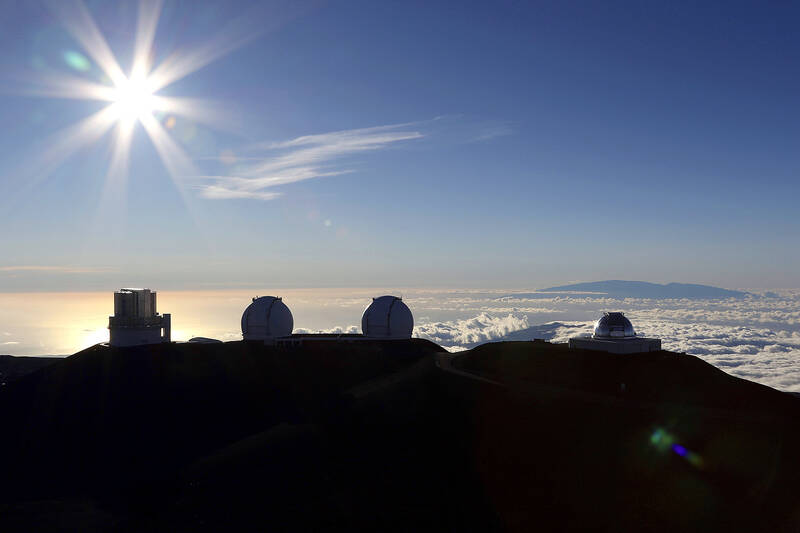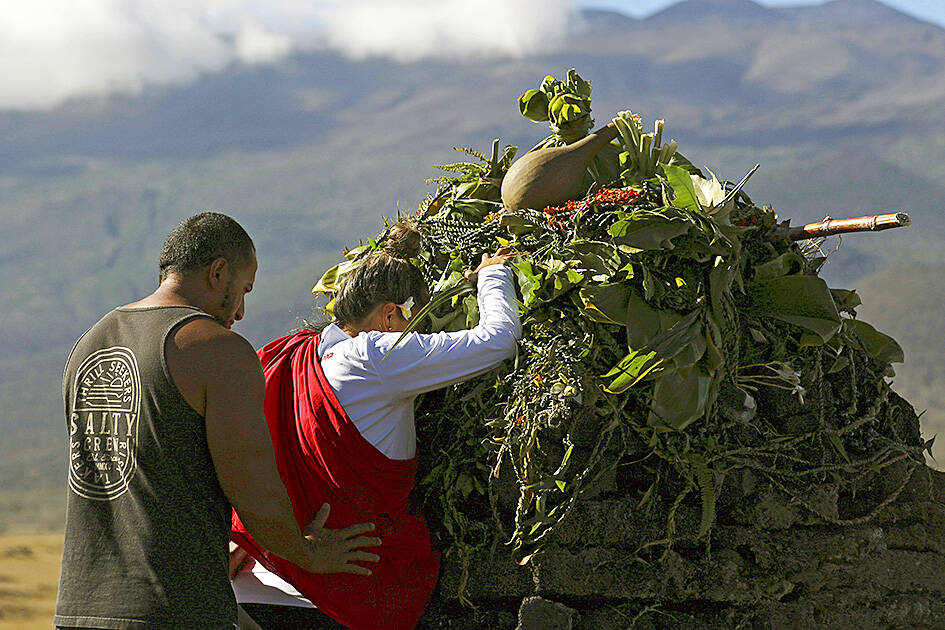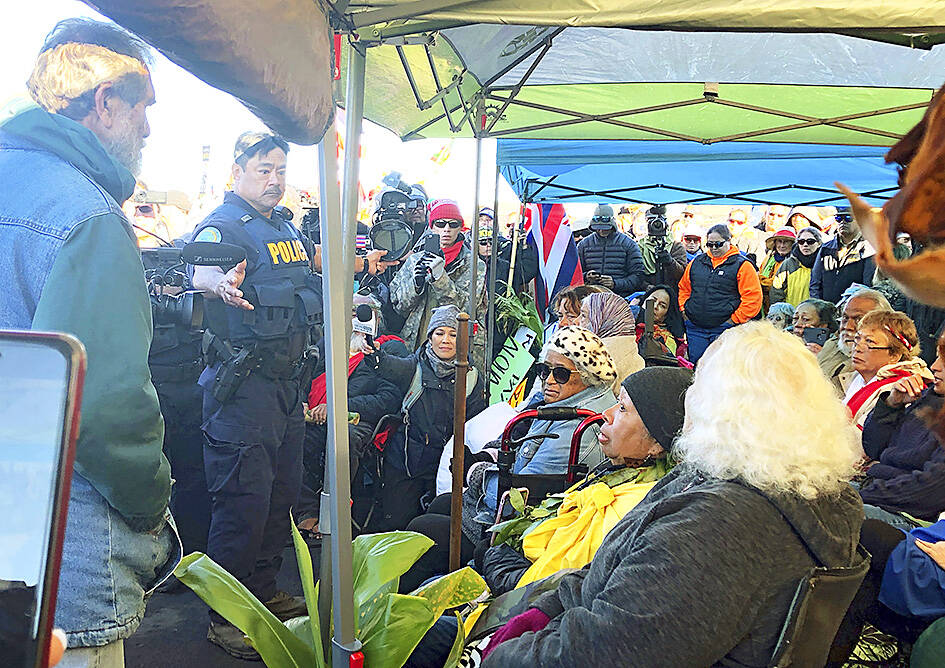For more than 50 years, telescopes and the needs of astronomers have dominated the summit of Mauna Kea, a mountain sacred to Native Hawaiians that’s also one of the finest places in the world to study the night sky.
That’s now changing with a new state law saying Mauna Kea must be protected for future generations and that science must be balanced with culture and the environment. Native Hawaiian cultural experts will have voting seats on a new governing body, instead of merely advising the summit’s managers as they do now.
The shift comes after thousands of protesters camped on the mountain three years ago to block the construction of a state-of-the-art observatory, jolting policymakers and astronomers into realizing the status quo had to change.

Photo: AP
There’s a lot at stake: Native Hawaiian advocates want to protect a site of great spiritual importance. Astronomers hope they’ll be able to renew leases for state land underneath their observatories, due to expire in 11 years, and continue making revolutionary scientific discoveries for decades to come. Business and political leaders are eager for astronomy to support well-paying jobs in a state that has long struggled to diversify its tourism-dependent economy.
To top if off, the new authority may offer a first-in-the-world test case for whether astronomers can find a way to respectfully and responsibly study the universe from indigenous and culturally significant lands.
“We’ve been here for centuries. We are not gone; we are still here. And we have knowledge that would produce a feasible management solution that would be more inclusive,” said Shane Palacat-Nelson, a Native Hawaiian who helped draft a report that laid the foundation for the new law.

Photo: AP
INCLUSIVE GOVERNING BODY
At issue is the summit of Mauna Kea, which sits 4,207 meters above sea level. In 1968, the state gave the University of Hawaii a 65-year lease for land that the school subleases to leading global research institutions in exchange for a share of observation time.
Astronomers like Mauna Kea’s summit because its clear skies, dry air and limited light pollution make it the best place to study space from the Northern Hemisphere. Its dozen huge telescopes have played key roles in advancing humanity’s understanding of the universe, including making some of the first images of planets outside our solar system.

Photo: AP
Astronomer Andrea Ghez used one to prove the existence of a supermassive black hole at the center of our galaxy, for which she shared the 2020 Nobel Prize in physics.
But the telescopes have also changed the summit landscape and have increasingly upset Native Hawaiians who view the place as sacred. The 2019 protests by people calling themselves kia’i, or protectors of the mountain, were aimed at stopping the construction of the biggest and most advanced observatory yet: the US$2.65 billion Thirty Meter Telescope, or TMT, backed by the University of California and other institutions.
Law enforcement arrested 38 elders, mostly Native Hawaiians, which only attracted more protesters. Police withdrew months later after TMT said it wouldn’t move forward with construction right away. Protesters stayed put but closed camp in March 2020 amid concerns about COVID-19.
The episode pushed lawmakers to seek a new approach.
The result is the new governing body, the Mauna Kea Stewardship and Oversight Authority, which will have a board of 11 voting members. The governor will appoint eight. Gov. David Ige hasn’t set a date for announcing his nominees, who will go before the state Senate for confirmation. He said more than 30 have applied.
TRADITIONAL KNOWLEDGE
Palacat-Nelsen said traditional Native Hawaiian knowledge could help the authority determine how large a footprint manmade structures like telescopes should have at the summit.
“Do we take heavy steps? Do we take light steps? When do we take steps? What seasons do we take steps?” Palacat-Nelsen said. “All that type of knowledge is embedded in the majority of our stories, our traditional stories that were handed down.”
The board will have this expertise because one member of the authority must be a recognized practitioner of Native Hawaiian culture and another a direct descendant of a Native Hawaiian practitioner of Mauna Kea traditions.
Central to the Native Hawaiian view of Mauna Kea is the idea that the summit is where gods dwell and humans aren’t allowed to live. A centuries-old chant says the mountain is the oldest child of Wakea and Papawalinu’u, the male and female sources of all life. To this day, the mountain draws clouds and rainfall that feeds forests and fresh water to communities on Hawaii’s Big Island.
Lawmakers drafted the law after a working group of Native Hawaiian cultural experts, protesters, observatory workers and state officials met to discuss Mauna Kea. Their report, which dedicated a large chunk to the historical and cultural significance of the mountain, formed the foundation of the new law. Several kia’i who served on that working group support the authority. The House speaker has nominated one kia’i leader for the board.
But some longtime telescope opponents are critical, creating questions about how broad the authority’s community support will be.
Kealoha Pisciotta, who has been part of legal challenges against TMT and other observatory proposals since 1998, said Native Hawaiians should at minimum have an equal standing on the board.
“You don’t have a real say. It’s designed to create an illusion of having consent and representation in a situation where we really don’t,” said Pisciotta, a spokesperson for the groups Mauna Kea Hui and Mauna Kea Aina Hou.
Lawmakers said the pressure to address Hawaii’s telescope standoff isn’t just coming from within the state but also from the US astronomy community.
State Rep. David Tarnas pointed to a report by a committee of astronomers from across the country declaring there’s a need to develop a new model of collaborative decision-making together with Indigenous and local communities. “This is not just the Big Island issue, it’s not just a state issue, but I believe it’s a global issue,” said state Sen. Donna Mercado Kim. “I believe that the world is watching to see how we deal with this.”
UNRESOLVED MATTER
The TMT matter, meanwhile, remains unresolved: Its backers still want to build on Mauna Kea, though they have selected a site in Spain’s Canary Islands as a backup.
The head of the University of Hawaii’s astronomy program said the authority could help his own institution if it “stabilizes the whole situation” for Mauna Kea astronomy.
But Doug Simons said he’s worried the authority might not get up and running in time to renew the summit master lease and subleases.
The master lease requires that all existing telescopes be decommissioned and their sites restored to their original state by 2033 if the state doesn’t authorize an extension.
Simons said it will take at least five or six years to dismantle the telescopes and associated infrastructure. That means new lease arrangements must be ready by 2027 or the observatories will have to begin winding down.
“There’s no obvious way around this,” Simons said. He said he’s pressing for the authority to be established as soon as possible to maximize time for negotiations and inevitable legal challenges.
Rich Matsuda, who works for W.M. Keck Observatory and served on the working group, urged the eventual board members to avoid being “stakeholders with narrow interests just trying to ensure that they get their piece of the pie.”
Tensions over telescope construction, he said, caused people to lock down and avoid discussing difficult issues surrounding Mauna Kea. The new law’s prioritization of the mountain’s well being may alter that, he said.
“My hope is that this gives us a chance, if we do it right, to change that dynamic,” Matsuda said.

The canonical shot of an East Asian city is a night skyline studded with towering apartment and office buildings, bright with neon and plastic signage, a landscape of energy and modernity. Another classic image is the same city seen from above, in which identical apartment towers march across the city, spilling out over nearby geography, like stylized soldiers colonizing new territory in a board game. Densely populated dynamic conurbations of money, technological innovation and convenience, it is hard to see the cities of East Asia as what they truly are: necropolises. Why is this? The East Asian development model, with

June 16 to June 22 The following flyer appeared on the streets of Hsinchu on June 12, 1895: “Taipei has already fallen to the Japanese barbarians, who have brought great misery to our land and people. We heard that the Japanese occupiers will tax our gardens, our houses, our bodies, and even our chickens, dogs, cows and pigs. They wear their hair wild, carve their teeth, tattoo their foreheads, wear strange clothes and speak a strange language. How can we be ruled by such people?” Posted by civilian militia leader Wu Tang-hsing (吳湯興), it was a call to arms to retake

This is a deeply unsettling period in Taiwan. Uncertainties are everywhere while everyone waits for a small army of other shoes to drop on nearly every front. During challenging times, interesting political changes can happen, yet all three major political parties are beset with scandals, strife and self-inflicted wounds. As the ruling party, the Democratic Progressive Party (DPP) is held accountable for not only the challenges to the party, but also the nation. Taiwan is geopolitically and economically under threat. Domestically, the administration is under siege by the opposition-controlled legislature and growing discontent with what opponents characterize as arrogant, autocratic

Desperate dads meet in car parks to exchange packets; exhausted parents slip it into their kids’ drinks; families wait months for prescriptions buy it “off label.” But is it worth the risk? “The first time I gave him a gummy, I thought, ‘Oh my God, have I killed him?’ He just passed out in front of the TV. That never happens.” Jen remembers giving her son, David, six, melatonin to help him sleep. She got them from a friend, a pediatrician who gave them to her own child. “It was sort of hilarious. She had half a tub of gummies,